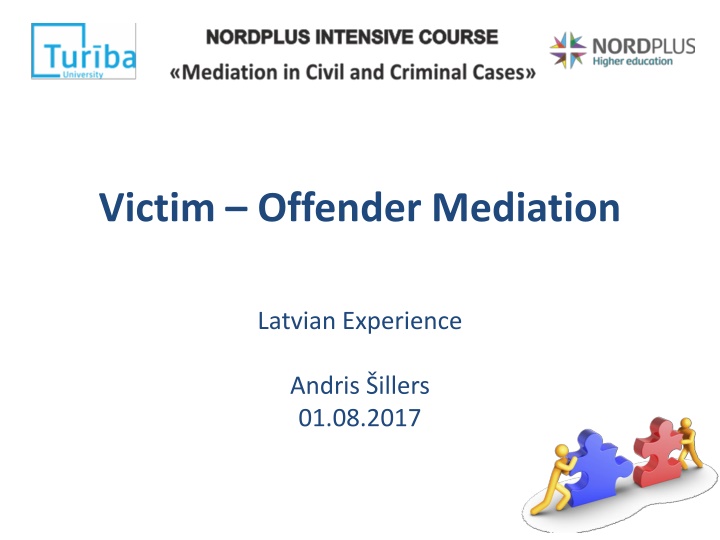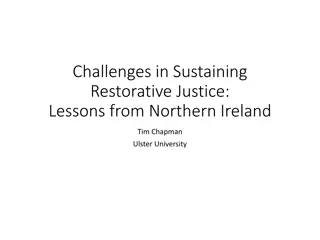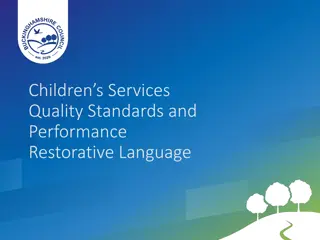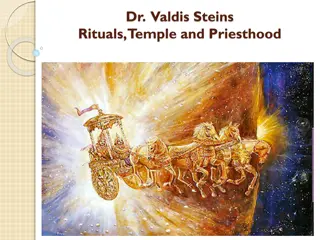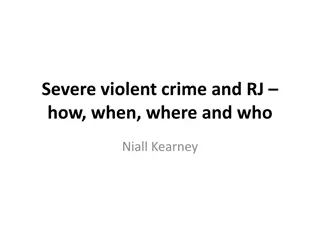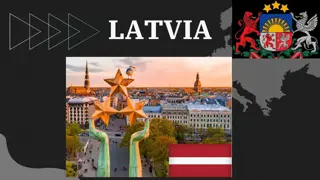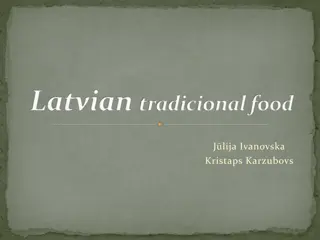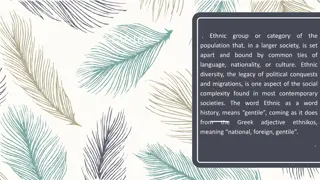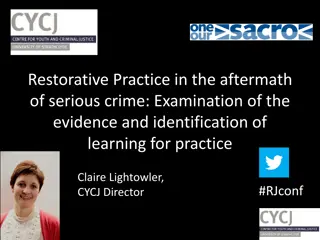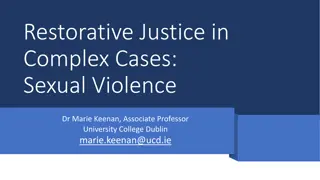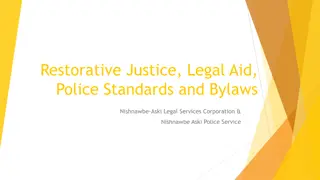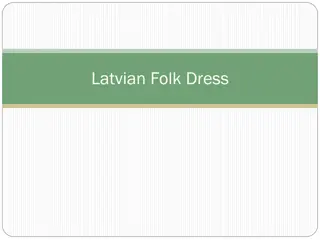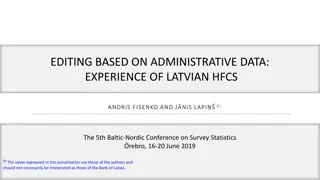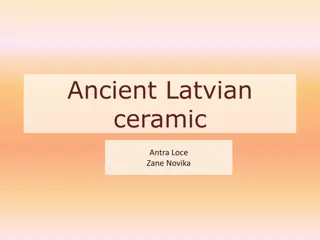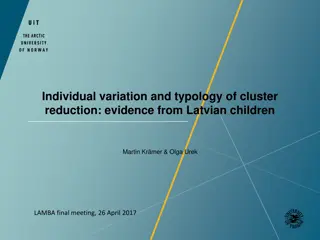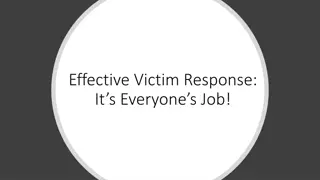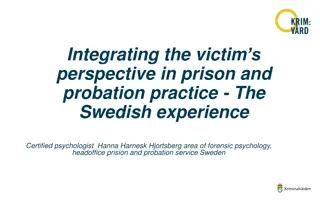Restorative Justice in Latvia: Latvian Ethnic Diversity and Victim-Offender Mediation
"Explore the practice of victim-offender mediation in Latvia, focusing on the diverse ethnic groups and the principles of restorative justice. Learn about the Latvian population and the importance of addressing harms and needs through inclusive processes. Discover the unique approach to justice that emphasizes repairing harm over punishment."
Download Presentation

Please find below an Image/Link to download the presentation.
The content on the website is provided AS IS for your information and personal use only. It may not be sold, licensed, or shared on other websites without obtaining consent from the author.If you encounter any issues during the download, it is possible that the publisher has removed the file from their server.
You are allowed to download the files provided on this website for personal or commercial use, subject to the condition that they are used lawfully. All files are the property of their respective owners.
The content on the website is provided AS IS for your information and personal use only. It may not be sold, licensed, or shared on other websites without obtaining consent from the author.
E N D
Presentation Transcript
Victim Offender Mediation Latvian Experience Andris illers 01.08.2017
Latvia Population 1,978 million 1/3 of population lives in Riga Ethnic groups: - 61.1% Latvian - 26.2% Russian - 3.5% Belarussian - 2.3% Ukrainian - 2.2% Polish - 1.3% Lithuanian - 3.4% Other Official language Latvian, belongs to Indo-European language family Latvia has ethnic and linguistic ties to Lithuania
Restorative Justice Howard Zehr To put right the wrongs
Five Principles of Restorative Justice 1. Focuses on harms and consequent needs (victims', but also communities' and offenders') 2. Addresses obligations resulting from those harms (offenders' but also families', communities' and society's) 3. Uses inclusive, collaborative processes. 4. Involves those with a legitimate stake in the situation (victims, offenders, families, community members, society) 5. Seeks to put things right.
Focus on Needs and Roles Victim needs Information why, tell what happened, gain control, restitution Offender accountability what has been done, understand impact on their behavior Community involvement secondary victims, mutual accountability, preventive actions
Two Different Views Criminal Justice Restorative Justice Crime is a violation of the law. Violations create guilt. Justice requires the state to determine blame (guilt) and impose pain (punishment). Central focus: offenders getting what they deserve. Crime is a violation of people. Violations create obligations. Justice involves victims, offenders and community members. Focus: victim needs and offender responsibility for repairing harm.
Restorative Justice Restorative Justice is a problem-solving approach to crime which involves the parties themselves, and the community generally, in an active relationship with statutory agencies. /Tony F. Marshall/
Victim Offender mediation (VOM) VOM - voluntary face-to-face negotiations between the victim and the offender, held by a neutral person mediator, who gives assistance to the parties involved to reach mutually acceptable, impartial and just solution.
Mediator Recruitment and selection 28 h training course 3 mediations under supervision Final test 6 - 20 mediations in 2 year period Every 12 month 8 h additional training After 24 months recertification
When is VOM possible In all types and stages of Criminal procedure. Application may be required by: parties (victim, offender, parents); police; public prosecutor; court; judge (cases of Law on Compulsory Measures of Correctional Nature for Children).
The main principles of VOM Face to face meeting (exception when victim is minor); Voluntary participation; The offender admits wrongdoing; Parties are free to refuse negotiations at any time; Supporters of the parties or other affected persons may be involved ; Mediator - process, neutrality and confidentiality.
VOM Session Preparing parties Ensure comfortable conditions Lead mediation process Session 1 2 h Number of sessions depends on a case
VOM Session Fact checking and negotiations I Stage past What happened? How? Where? Who was involved? II Stage present What do you think about the incident now? What are consequences? How do you feel about what happened now? III Stage future What should be done to leave incident in the past? What solution do you see? Victim and offender contract
VOM Session Mediator Victim Offender Supporter Supporter Mediator
Conferencing Negotiations are guided by a special script. Participate those who have been affected by the offense. More participants (social pedagoues, police, children protection officers etc). Always two falicitators.
Conferencing Facilitator Offender Victim Supporter Supporter School representative Community representative Facilitator
Victim benefits of VOM A chance to express feelings and viewpoint about the incident directly. Receive answers on significant questions. Maintain neutral relationship with offender. An opportunity to receive restitution faster.
Offender benefits of VOM An opportunity explain reasons for wrongdoing. Restitute victim. Understand consequences of incident for victim. Receive less severe punishment.
Kriminllikuma pants (pilngad gie un nepilngad gie) 2016 415 2015 307 Par z dz bu, kr p anu vai piesavin anos neliel apm r (KL 180/1) Par z dz bu, ja t izdar ta, iek stot dz vokl vai cit telp , vai ja t izdar ta no glab tavas vai transportl dzek a (KL 175/3) Par sve as mantas t u izn cin anu vai boj anu (KL 185/1) Par sve as kustamas mantas slepenu vai atkl tu nolaup anu (z dz ba) (175/1) Par viegla miesas boj juma t u nodar anu (KL 130/2) Par ce u satiksmes noteikumu vai transportl dzek u ekspluat cijas noteikumu p rk p anu (260/1, 260/1.1) 182 247 218 49 205 75 77 38 52 46 37 43 Par t da miesas boj juma t u nodar anu, kas izrais jis ilgsto u vesel bas trauc jumu vai visp r jo darbsp ju iev rojamu palieko u zaud anu maz k nek vienas tre da as apm r (KL 126/1) Par laup anu, ja to izdar jusi personu grupa p c iepriek jas vieno an s vai ja t izdar ta, iek stot dz vokl vai cit telp (176/2) 29 26 19 Par hulig nismu, ja to izdar jusi personu grupa vai ja tas saist ts ar miesas boj jumu nodar anu (231/2) Par z dz bu, ja to izdar jusi personu grupa p c iepriek jas vieno an s (175/2) Par sve as kustamas mantas nolaup anu, ja t saist ta ar vardarb bu vai vardarb bas piedraud jumu (laup ana) (176/1) Par sve a finan u instrumenta vai maks anas l dzek a nolaup anu, izn cin anu, boj anu vai nelikum gu izmanto anu (193/2) 22 26 20 26 20 19 14 15 14 13 11 Par sve as mantas prettiesisku ieg anu vai iz rd anu (179/1) Par sve as mantas vai ties bu uz du mantu, vai citu mantisku labumu ieg anu, apzin ti ievadot automatiz t datu apstr des sist m nepatiesus datus (177/1) Un citi (KL 109/1, 132, 143, 231/2, 174, 230/1, 275/2 ) L dz 10 L dz 10
Conditions Work 3% Material compensation & work 1% Other 10% Apology 22% Moral compensation 4% Compensation (moral & material) 9% Material compensation 51%
Restorative Justice All violence is an effort to achieve justice or to undo injustice. /James Gilligan/ In other words, much crime may be a response to an effort to undo a sense of victimization.
